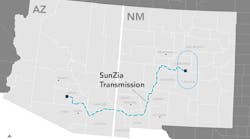Pattern Energy Signs Long-Term Power Purchase Agreements for SunZia Wind Project
Pattern Energy Group has secured long-term Power Purchase Agreements (PPAs) with Shell Energy North America and the Regents of the University of California for a portion of the power generated by its SunZia Wind project. Construction of the project, which is expected to commence later this year, aims to be completed by 2026 – supplying power to western energy markets.
The SunZia Wind project, encompassing over 3,500 MW of new wind generation in New Mexico’s Torrance, Lincoln, and San Miguel Counties, is set to become the largest wind project in the Western Hemisphere. It will benefit from SunZia Transmission, a 550-mile high-voltage direct current (HVDC) transmission line connecting central New Mexico to south-central Arizona. With a transport capacity of 3,000 MW, SunZia Transmission will enable the delivery of clean, renewable energy to customers in Arizona and California during peak demand periods when renewable energy supply is typically low.
Both the SunZia Wind and SunZia Transmission projects prioritize local community engagement and environmental stewardship. SunZia Transmission, in collaboration with conservation stakeholders, has developed a gold standard in environmental mitigation efforts, including wildlife habitat restoration and investment in emerging technology and conservation research. SunZia Wind has implemented robust environmental practices to minimize project impacts and partnered with local and state experts to study effective habitat restoration strategies.
A recent independent study conducted by Energy, Economic & Environment Consultants revealed that the SunZia Transmission and SunZia Wind projects are expected to generate a total economic benefit of $20.5 billion. This includes over $8 billion in direct capital investment, with no additional costs passed onto ratepayers. The projects are estimated to contribute $1.3 billion in fiscal impacts to governments, communities, and schools through sales and use taxes, property taxes, community benefit payments, and land payments to federal and state agencies.
The projects are working closely with federal agencies, such as the Bureau of Land Management (BLM), as well as local jurisdictions and stakeholders to secure the remaining approvals required for construction to commence as scheduled later in 2023.


